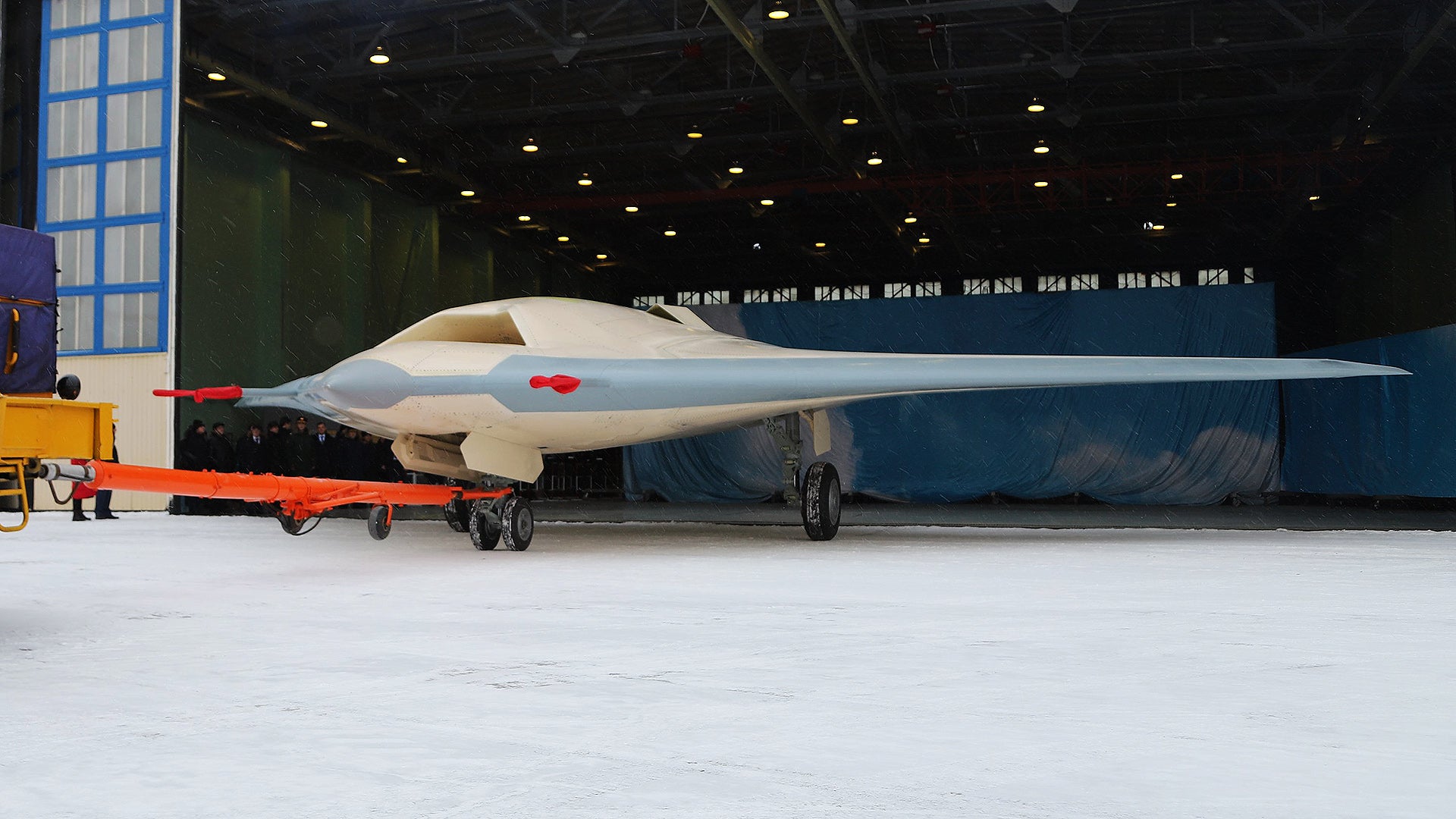The second flying prototype of Russia’s S-70 Okhotnik unmanned combat air vehicle (UCAV) has emerged, and it features the long-awaited stealthier nozzle configuration, among many other refinements, that should maximize the low observability and combat effectiveness of the production version. While the redesigned Sukhoi drone has yet to fly and still has a long series of evaluations ahead of it, Russian Minister of Defense Sergei Shoigu has confidently predicted that test work could be completed sometime next year, paving the way for an order for the Russian Aerospace Forces, or VKS.
The more production-representative flying-wing UCAV was rolled out today at the Novosibirsk Aircraft Production Association, or NAPO, in southwestern Siberia, where the drones are being built on behalf of the Sukhoi design bureau. The unveiling of the second Okhotnik was attended by Russian Deputy Minister of Defense Alexei Krivoruchko.

“The roll-out of the UAV marks the completion of the assembly of the product as a whole, equipping it with all the necessary onboard equipment in accordance with the requirements for the aircraft, and the transition to complex ground tests to prepare for the first flight,” Krivoruchko said.
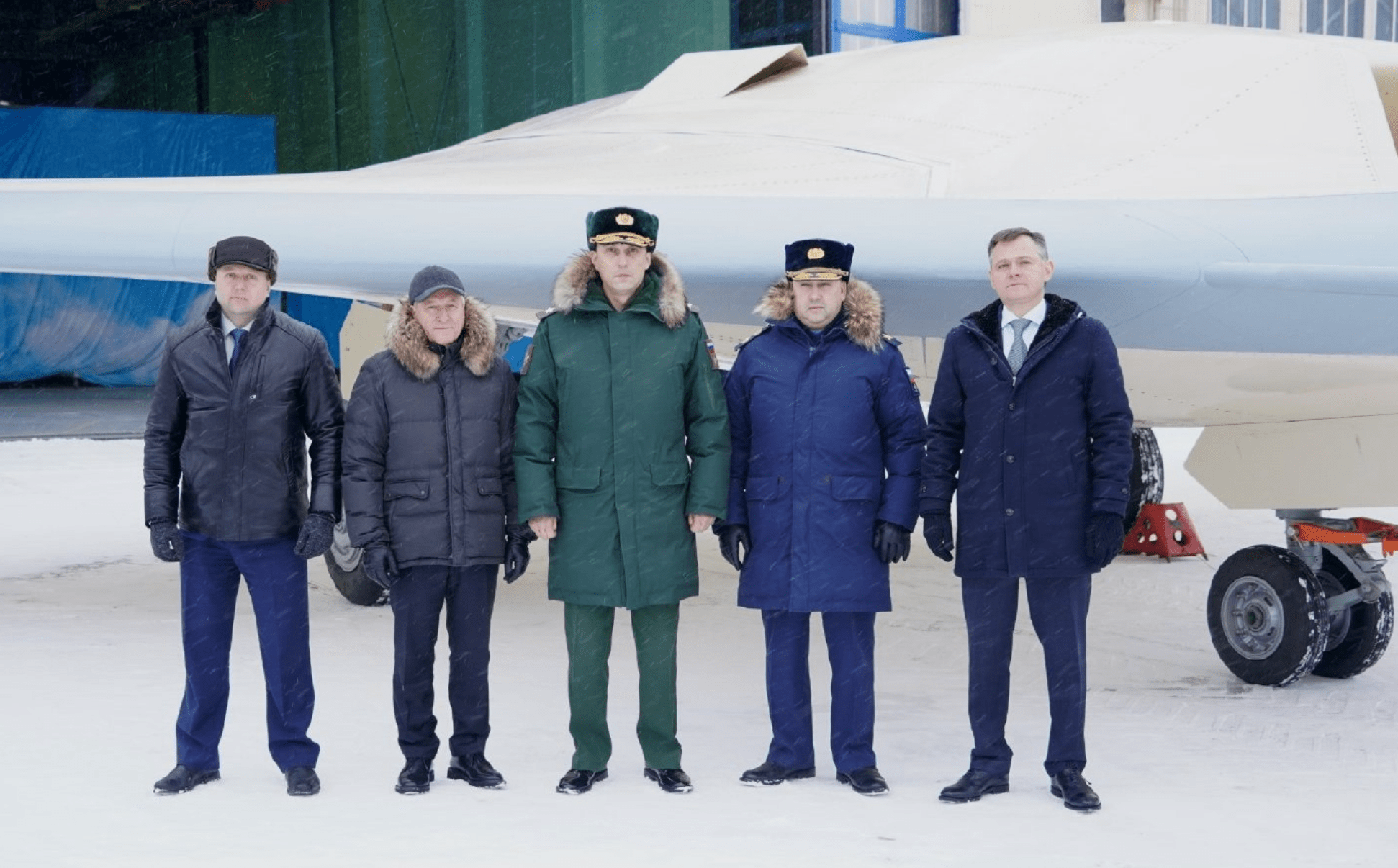
As for the engine used in the Okhotnik, this was previously reported to be a variant of the AL-41F turbofan that powers the Su-35 Flanker multirole fighter and initial versions of the Su-57 Felon new-generation fighter. It’s unclear whether the second prototype retains the same powerplant, but it’s obvious the engine exhaust has been entirely reworked, with the new, flat jet nozzle tailored to reduce infrared and radar signatures.
The existence of a stealthier version of the Okhotnik had long been anticipated, with a model of the revised design appearing at the International Aviation and Space Salon, or MAKS, outside Moscow in August 2019, in the same month that the first prototype recorded its maiden flight.

The first prototype clearly had significant design issues that detracted heavily from achieving all-aspect low-observability, which you can read about in our initial analysis of this topic here.
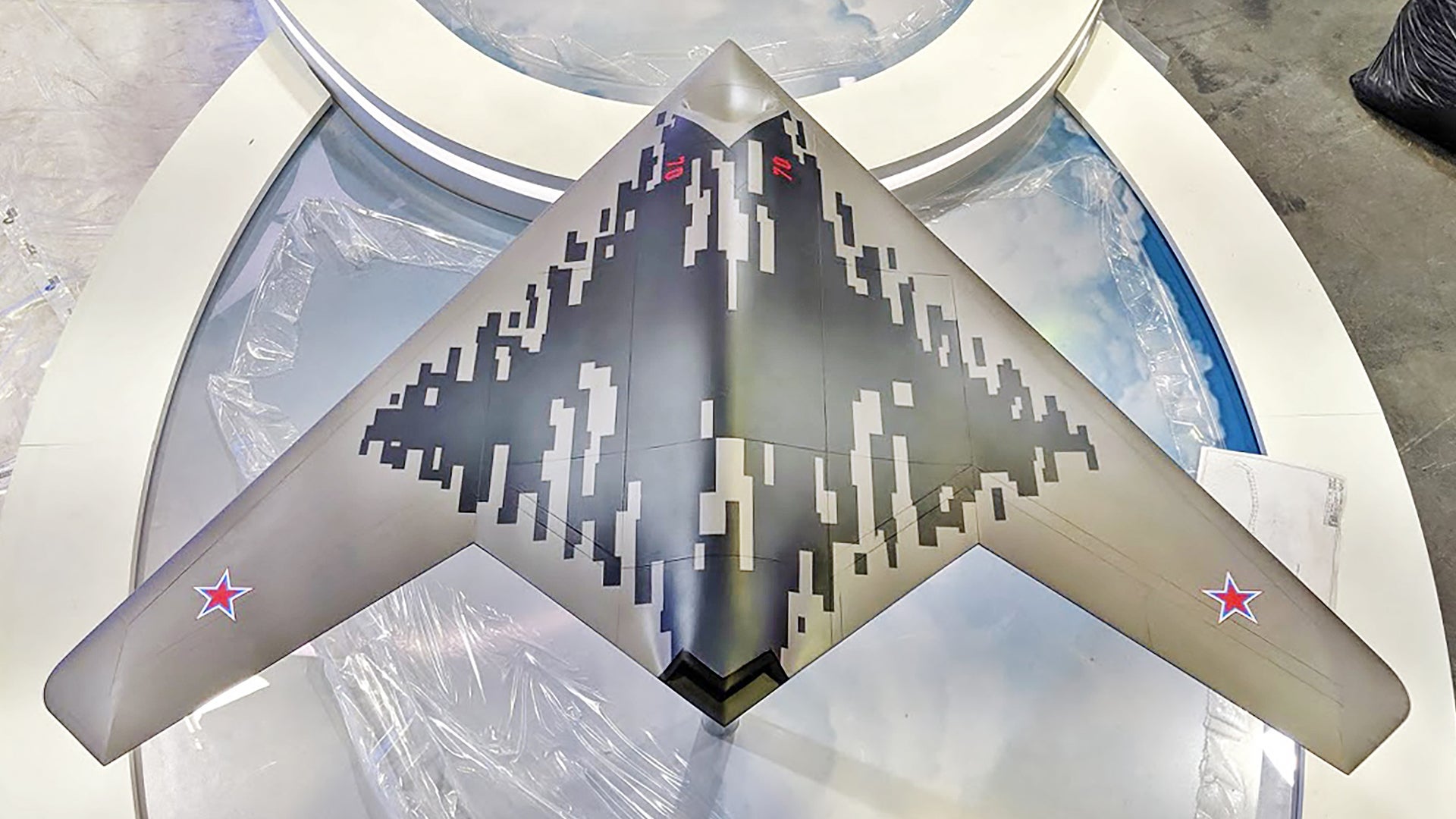

The model at MAKS 2019 showed a much cleaner design, with the various antennas, small air inlets, and exhaust vents removed from its outer mold line. This seems to hold for the second prototype, the surfaces of which are relatively unblemished, at least at the time of the rollout. Although a pair of air-data probes remains, it is likely intended that these would be deleted from production versions. There is also an unusual pair of air inlets atop the primary intake, the purpose of which is unclear, although it isn’t unusual for a stealthy aircraft to have such features.
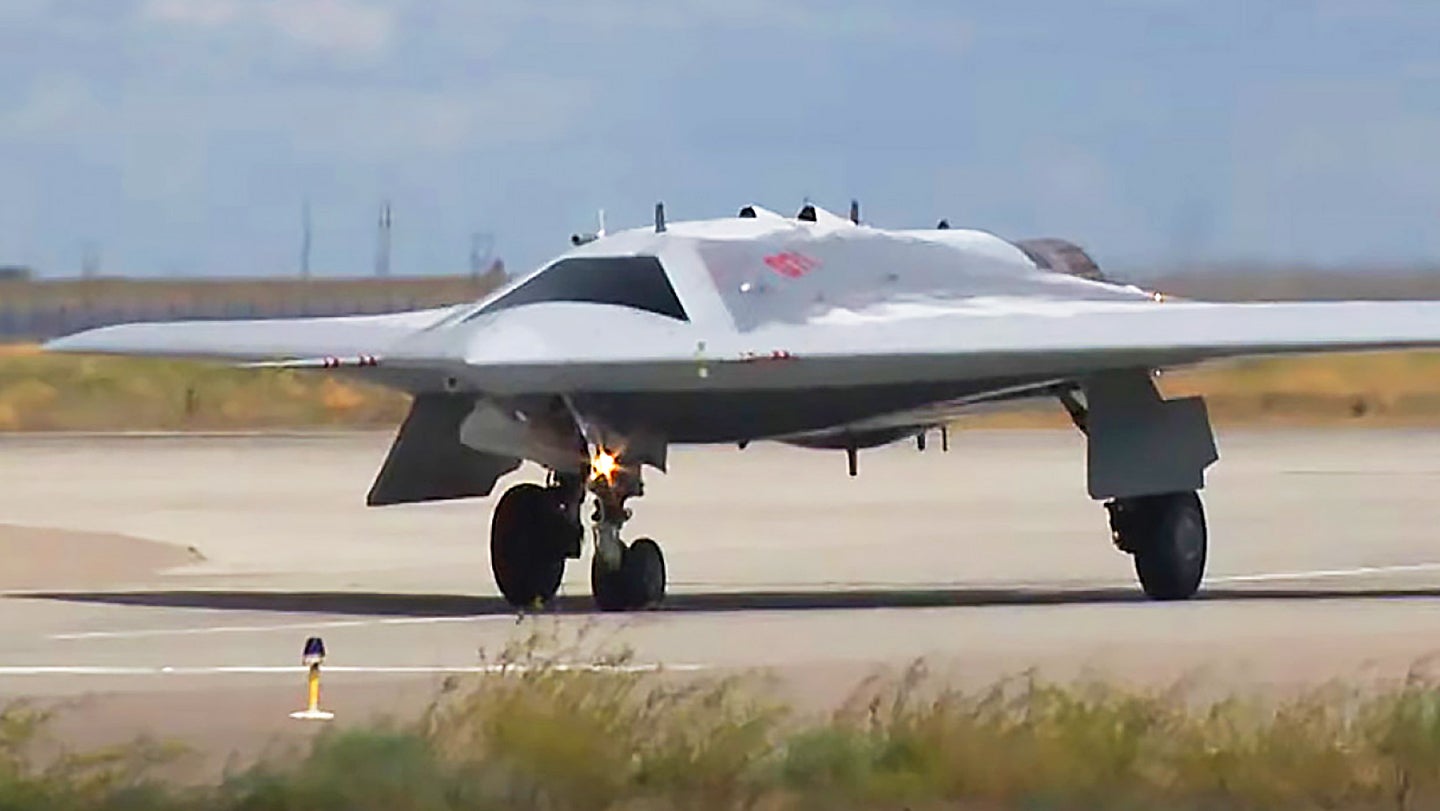
The drone is also yet to be fully painted and may eventually adopt the ‘pixelated’ pattern shown on the MAKS model. As it is now, the second prototype reveals distinctive blue/gray colored panels along the leading edges of the wing and the nose. The leading edge of the wing, in particular, is critical for managing low observability, and it’s possible these areas have been treated with radar-absorbent material, or RAM, and/or have radar-wave deadening structures beneath an outer shell that is transparent to certain bandwidths. The ability to embed sensors beneath this outer skin could also be a primary driver on the material used.
Overall, the second prototype Okhotnik seems to have achieved, superficially at least, most of the signature-reduction measures that were anticipated by the MAKS model. The most fundamental advance is the exhaust and, as expected, this broadly follows the pattern found on the Boeing X-45A demonstrators. Protruding decking above and below the exhaust will help shield its infrared and radar signatures from most aspects, especially from above and below.
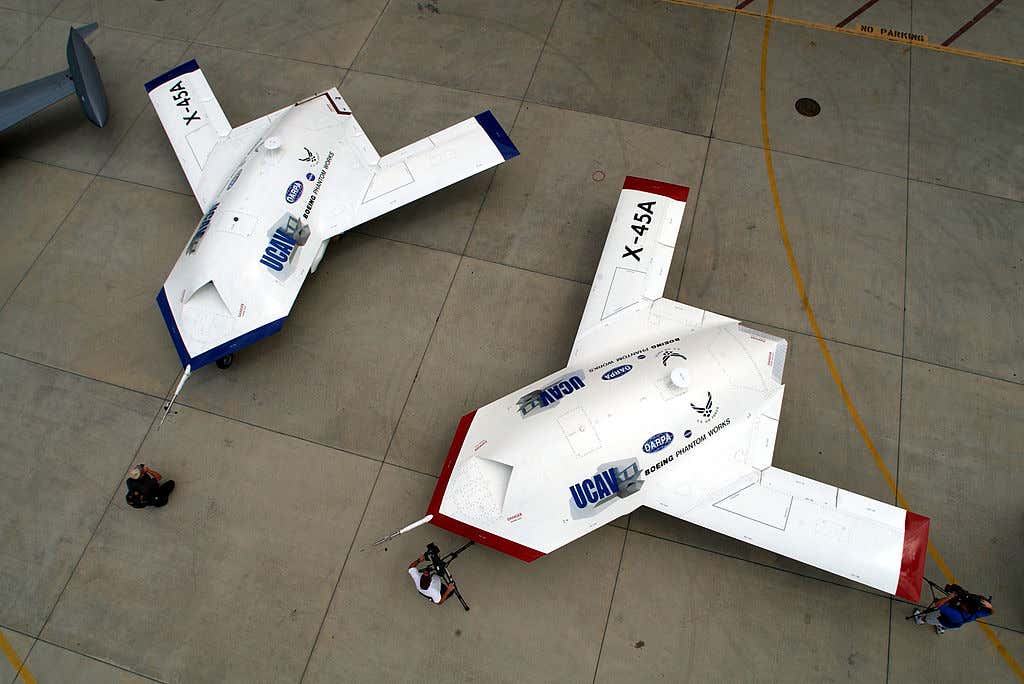
Beyond the deletion of many humps and aerials, overall, this version of the Okhotnik has an outer skin that is more refined, with fewer seams and traditional mechanical fasteners visible. This is similar to the difference we have seen between the T-50 prototypes and the more refined production-representative Su-57s.
Taken as a whole, this latest S-70 derivative does seem to represent a leap forward in Russia’s ability to execute on low-observable technologies and manufacturing abilities, even if it still lags behind some of its peers. Still, just rolling out this aircraft does not mean it will all work as advertised. Two very challenging elements of low-observable design, and especially when applied to flying wings, are the exhaust and gathering reliable air data without compromising stealth. So, we will have to wait and see how successful Russia is at making the new exhaust work and eventually deleting the air data probes that severely compromise the Okhotnik’s stealth potential.
Making the most of the S-70’s stealth capabilities appears to be a key component in how the type will fit into Russia’s air combat architecture, as we have considered in the past. Ultimately, the aim appears to be to field an Okhotnik UCAV with a substantially low-observable design to compensate for some of the stealthy shortcomings of the Su-57 Felon. This would make more sense bearing in mind the fact that the Okhotnik is supposed to work alongside the Felon as part of a Russian version of the ‘loyal wingman’ concept. It will also be able to work independently, which will also require a greater degree of low observability for many missions than its manned stablemate.

Krivoruchko’s visit to Novosibirsk brought further confirmation that the Okhotnik is intended to operate alongside manned aircraft as well as independently, either alone or as part of a larger formation. “Okhotnik is a highly intelligent system capable of solving a wide range of tasks individually, in a group and together with manned aircraft,” Russia’s state-run media outlet RIA Novosti reported, citing the deputy defense minister.
In the past, the General Director of Russia’s United Aircraft Corporation, Yury Slyusar, has described the Okhotnik, which means “hunter” in Russian, as an “attack heavy drone [sic] with unprecedented capabilities, having the largest combat flight range, the widest range of weapons [and] the broadest range of equipment.”
There appears to have been some effort already to test weapons from the Okhotnik, using the first flying prototype. Although firm details remain scarce, it was reported in December last year that the UCAV had been flight-tested with some kind of air-to-air missiles. The drone was said to have been outfitted with inert missiles, and it’s unclear if any live missile launches have taken place since.

According to today’s RIA Novosti report, the deputy defense minister also held a meeting with NAPO executives about future state contracts. While the facility is also responsible for building Su-34 Fullback tactical bombers for the VKS, in the past, it’s been reported that there are plans to have production versions of the Okhotnik in VKS service by 2024.
That, again, is an ambitious timeline, and during his visit to NAPO Krivoruchko noted that the production of the Okhotnik requires “a full cycle” of development and testing of all components, with most of the parts having been produced specifically for this application, rather than being procured off the shelf.
Various new technologies are in the works for the UCAV. These include a new and dedicated ground control station being developed by the Rostec concern.

“Technologies tested on the prototypes will be used in the creation of other promising aircraft systems — both manned and unmanned,” Krivoruchko added, perhaps hinting that the design and testing of the Okhotnik could inform Russia’s much-anticipated new strategic bomber, or PAK DA, which is similarly expected to be a flying-wing design. That is, if it ever actually materializes.
Even if there is no direct link between the two designs, the development of stealth technologies for the revised Okhotnik will surely be of considerable benefit to the Russian aerospace industry more generally as it continues to work on designs for new-generation combat aircraft. The United Aircraft Corporation (UAC) also foresees the potential for the development of a family of unmanned systems based on the same S-70 design. We look forward to hearing more about this in the future.
The Okhotnik is clearly still some way off from frontline service, and the ambitious timelines pitched so far in this regard currently look unlikely to be met. There are still significant hurdles to overcome, including ensuring the UCAV meets its low observable ambitions and works as an effective weapon enabled by command-and-control software and datalink architecture. However, Russia is meanwhile fast gaining useful operational experience with more modest drone designs. Maybe the most remarkable thing about the S-70 is its size — with a reported maximum takeoff weight of around 20 metric tons. This aircraft will have very long endurance with a sizeable combat load. How effectively it can be employed has to be seen.
More important, however, is the fact that the Okhotnik UCAV is now demonstrably on the way toward becoming a true low-observable combat aircraft. As such, it will likely break entirely new ground for the Russian military once it finally enters service, and it will very likely be offered for export, potentially bringing these advanced capabilities to other countries, too.
Contact the author: thomas@thedrive.com
